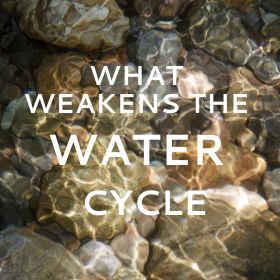The New Water Paradigm
Where does rain actually come from?
Most of us know the “classic” water cycle from school: the sun warms the oceans, lakes, and rivers. Water evaporates, rises into the sky, condenses into clouds, and eventually falls as rain or snow. Some of that water runs off across the land in rivers, streams, and groundwater, eventually returning to the sea — ready for the cycle to begin again.
This is the Large Water Cycle: the vast, planetary exchange of water between the oceans and the land. Every year, around 550,000 cubic kilometers of water evaporate into the atmosphere.
It’s a huge, global engine — but it’s not the whole story.
The Small Water Cycle
Alongside this great planetary loop, there is another, more intimate cycle — one that takes place right where we live. This is the small water cycle, and it turns out to be important for our climate and our daily lives.
In a healthy landscape, rainfall doesn’t just run off to the sea. It soaks into the soil, replenishing groundwater and feeding plants. Through their roots, plants and trees draw up this water and release it back into the air as invisible vapor. This process is called evapotranspiration. That vapor rises, cools, forms clouds, and falls again as rain.
A proportion of rainfall on land comes not from the sea at all, but from this recycling of water through soils, plants, and forests. That means the green landscapes around us are not only using water — they are actively helping to generate rain.
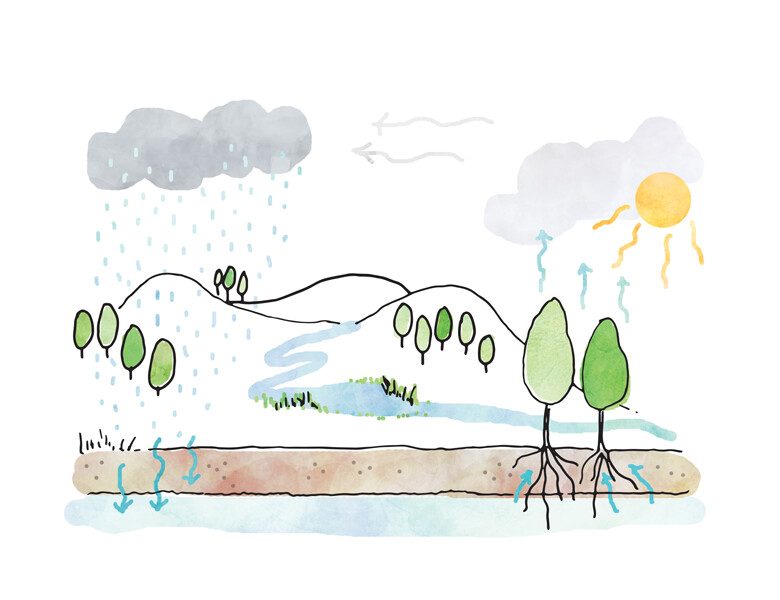
A significant proportion of rainfall on land comes from recycling through evapotranspiration by trees and other vegetation. Water is taken up by plant and tree roots and evaporates, condensates and falls as rain.
Nature as the Earth’s Cooling System
When sunlight reaches the Earth, that energy has to go somewhere. On bare soil, asphalt, or rooftops, most of it is converted directly into heat — warming the surface and the air above it. But in natural landscapes, something different happens.
Forests, wetlands, meadows, and even healthy soils act as giant natural air conditioners. Instead of letting the sun’s energy simply heat the land, they use it to evaporate water. This invisible process of turning liquid into vapor absorbs vast amounts of heat, carrying it upwards into the atmosphere. Later, when that vapor condenses into clouds and rain, the stored energy is released — high above the ground, rather than at the surface where we live.
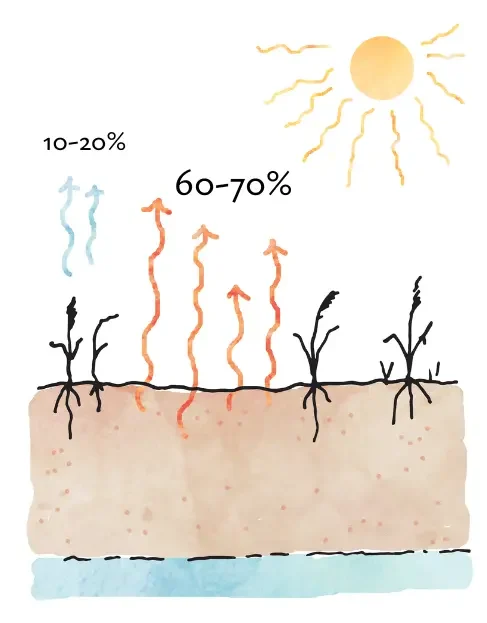
In a drained field, 60-70% percent of the sun’s energy becomes sensible heat – heat you can feel, and only 10-20% is used for evapotranspiration. Adapted from Kravčík et al.
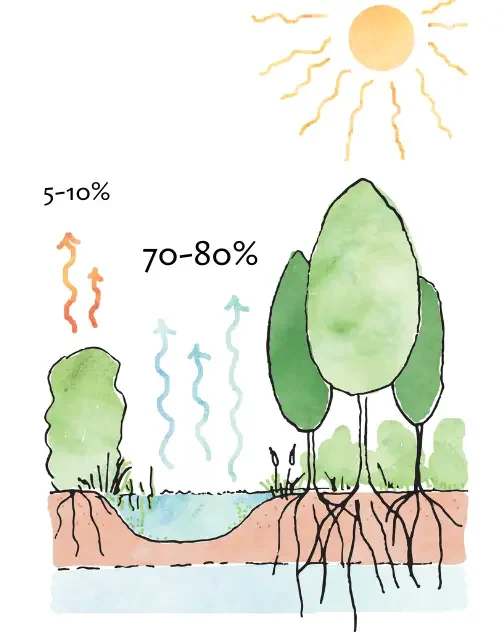
In a hydrated landscape, 70-80% percent of the sun’s energy is used for evapotranspiration, and only 5-10% becomes sensible heat – heat you can feel.
Adapted from Kravčík et al.
This means that vegetated landscapes cool themselves, and the air around them. That’s why a forest, a river valley, or a marsh feels cooler and more humid than the bare fields or streets nearby. It’s not magic — it’s physics. Nature transforms heat into water vapor and lifts it away, balancing energy in a way that bare soil, concrete, or dry land cannot.
The effect is huge. Studies show that in healthy ecosystems, as much as half of the sun’s incoming energy is used for evaporation and cooling, instead of for direct heating. Without this natural cooling, local climates swing more violently: hotter days, drier air, and greater extremes.
In short: vegetation and water are the Earth’s climate regulators. They stabilize temperatures, create clouds, and keep the small water cycle turning.
Why Vegetation matters so much…
For the small water cycle to generate rain and keep landscapes green, two ingredients are essential: water in the soil and living vegetation. One without the other is not enough.
Vegetation plays several hidden but crucial roles:
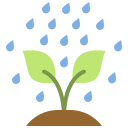
Slowing rain and guiding it into the ground
Leaves, branches, and roots interrupt the force of falling rain, preventing erosion and giving water time to soak into the soil rather than rushing away.

Creating sponge-like soils
In healthy ecosystems, roots, fungi, earthworms, and organic matter turn the soil into a living sponge that holds vast amounts of water. A forest soil can store several times more water than a degraded bare field.

Lifting water back to the sky
Through evapotranspiration, plants pump this stored water back into the atmosphere, creating the vapor needed for clouds and rain.

Supplying cloud seeds
Plants also release biological particles — tiny bits of pollen, spores, and organic compounds — that act as condensation nuclei, helping water vapor turn into droplets and form clouds.
This hidden partnership between water and vegetation is what keeps landscapes green, skies cloudy, and climates stable.
Remove the vegetation, and the sponge dries out.
Remove the water, and the plants wither.
But if both are present, then together, they weave the fabric of
the small water cycle;
a self-sustaining loop that nourishes both people and the planet.
The Hidden Rainmakers in the Air
Most of us think rain forms when moist air cools and condenses into clouds.
But there’s a hidden ingredient in every raindrop: a tiny particle at its center.
These are called condensation nuclei — and without them, clouds can’t form.
But here’s where it gets even more interesting:
- Not all condensation nuclei are equal.
Natural ecosystems — like forests, wetlands, and healthy soils — release particles that are especially good at creating clouds and rain. - Some of these are biological – Fungal spores, plant oils, pollen fragments, and even certain bacteria rise with water vapor from leaves and soils. These “bioaerosols” act as natural seeds for raindrops.
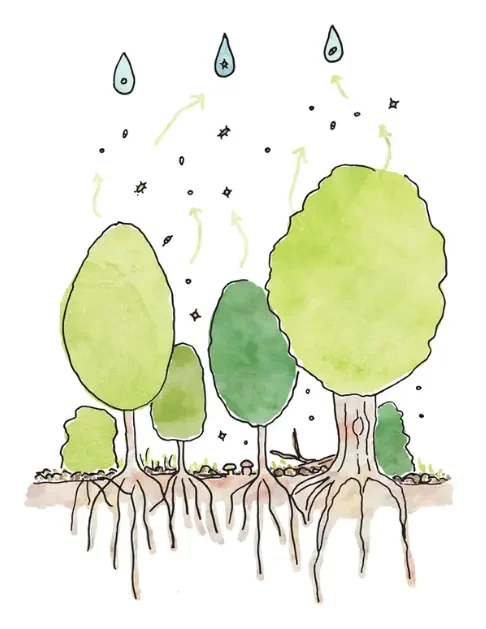
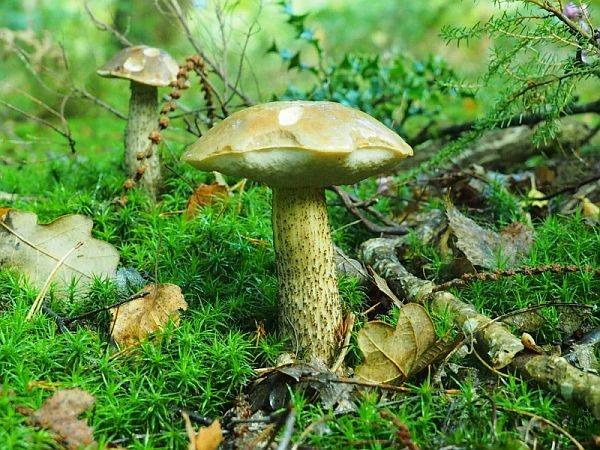
- Healthy forests are especially powerful. Diverse, multilayered forests with rich fungal networks release large amounts of spores that can trigger rain — even at warmer sub-zero temperatures where ordinary condensation wouldn’t work. This makes them crucial for rainfall in many temperate climate regions, including Southern Europe and Bulgaria.
- When ecosystems are degraded, the story changes.
Bioaerosols are replaced by dust, smoke, or soot — which behave very differently. Some may even inhibit rain or lead to more extreme weather. Some may even inhibit rain, or lead to more extreme weather.
That means ecosystems don’t just use rain —
they play an active role in making it possible.
Healthy landscapes full of life are also full of these rain-making particles. This is one of the many ways life supports life. The more alive and diverse a place is, the more likely it is to rain, cool, and thrive.
Trees in Cities: Nature’s Coolers Close to Home
What happens in forests and wetlands also happens — on a smaller scale — right where we live. A single tree is like a miniature climate regulator, quietly working to balance heat and water.
In cities, where concrete and asphalt soak up the sun and radiate it back as heat, temperatures can climb dramatically. This is the urban heat island effect — and it can make cities several degrees hotter than the countryside. But trees change that.
Every leaf is a tiny pump, drawing water from the soil and releasing it into the air. This process absorbs heat and creates cooler, more humid microclimates. A mature tree can release hundreds of liters of water a day as vapor — the cooling power of several air-conditioning units, but completely natural.
And then there’s the shade. Streets lined with trees can be 10–15°C cooler on a hot summer’s day compared to treeless streets. Shaded asphalt and buildings stay cooler, so people need less air conditioning and electricity bills are lower.
Without trees, heat lingers. With them, cities breathe easier and stay more livable — even in the face of rising temperatures.
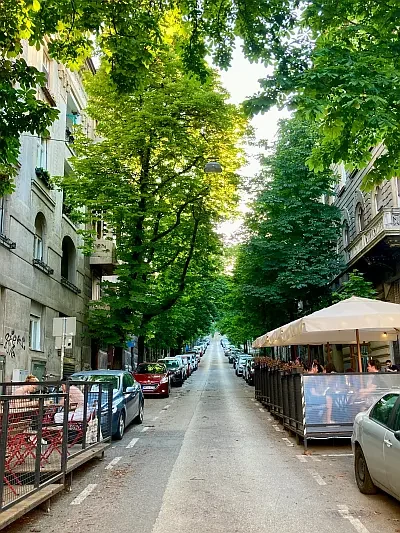
Trees make the city a much more pleasant place to live, especially when the weather is getting hotter.
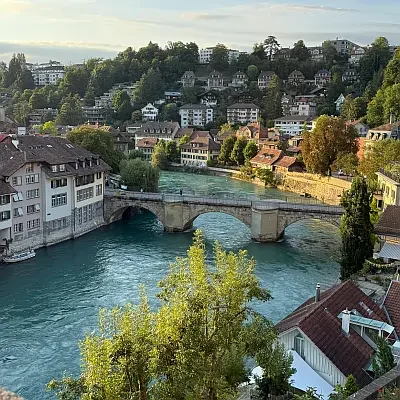
Did You Know?
In the late 1800s, the hills around Veliko Tarnovo were almost bare — stripped of trees and vulnerable to erosion. Summers were hot and dusty, with little shade to cool the city. But starting in 1898, local foresters and citizens started a huge tree planting campaign that changed everything. Tens of thousands of saplings were planted on the hillsides, transforming the landscape. What was once dry and exposed became green and shaded — and today, Veliko Tarnovo is surrounded by green woods that were carefully and lovingly restored more than a century ago.
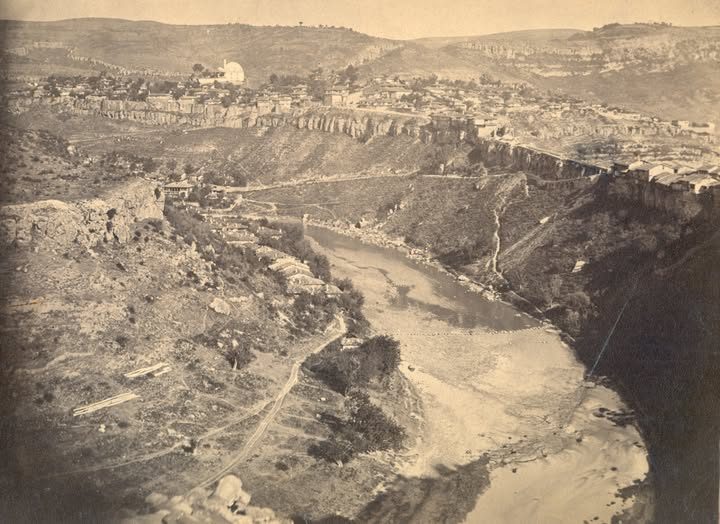
View on Veliko Turnovo – end of 19th century. Photo source: Regional History Museum – Veliko Turnovo.

A Bigger Picture: Forests and the Flow of Rain
By now, you’ve seen how vegetation plays a key role in the small water cycle — helping water rise from the land into the air, form clouds, and fall again as rain.
But what if these same principles also help shape regional and continental rainfall patterns that we would think of as the big water cycle?
That’s the idea behind the Biotic Pump theory — a developing idea that suggests forests don’t just take part in the small water cycle… they may help drive rainfall patterns also on a much larger scale.
The idea is that large, unbroken forests can actually pull moist air from the oceans far into the land. As trees release water and clouds begin to form, the condensation lowers air pressure, which draws in even more moist air from far away— creating a self-reinforcing cycle.

The decline of once-thriving civilisations?
Even on the big scale, Rainfall patterns may not be fixed.They may depend on the living systems that help generate them.
This theory is still evolving, but it points at an exciting possibility:
If land degradation helped disrupt rainfall and fuel desertification,then strategic ecosystem restoration might help reverse it.
Could many more parts of the Earth once again become lush, productive landscapes where humans and wildlife thrive — not through technological fixes, but by working with nature’s own rainmaking systems?
So what weakens the Water Cycle?

